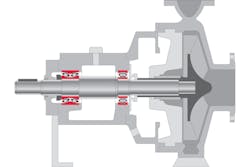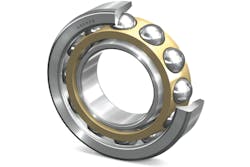A wide array of equipment is used to pump, meter and control fluids. The bearings used in that equipment are just as diverse.
Equipment such as centrifugal pumps, which keep the bearings away from the pumped media, can use bearing options that are standard across all industries. More extreme applications such as submersible cryogenic pumps or bi-rotor positive displacement meters expose the bearings to environments that require specialized bearing options to meet the life and performance expectations of the equipment end users. From a bearing standpoint, it comes down to the individual application. For any one application, a multitude of factors should be considered such as operating speed, load direction, load magnitude, lubrication used and the level of contamination it contains, temperature and required life, to name a few.
Cost and availability are always a part of the equation, too. Each equipment manufacturer balances the different requirements, often on a model by model basis, to determine what the bearing needs are. Some equipment is positioned to compete in a price-driven market, which results in a constant push for more cost-effective bearing options. Other equipment is marketed for its high reliability or is used in situations in which downtime must be avoided. For that equipment, cost is less of a factor and overall reliability of the entire system is critical. These needs are constantly shifting market forces and bearing manufacturers are always looking for ways to meet these demands from equipment manufacturers and end users.
Advancements in bearing technology
Top-tier bearing manufacturers continually work on new innovations and improvements to meet the needs of the fluid movement industry. One of the areas is continuous improvement of "standard" products. From the cleanliness and quality of the initial pour of the material at the steel mill, through the various manufacturing processes required to create the bearing and even to the packaging and logistics management used to deter counterfeits, advancements in bearing technology happen all the time.
New cage materials and designs are introduced to allow higher speed operation or lower heat generation. Higher-capacity, internal bearing designs are developed to extend bearing life past that of previous design iterations. Surface finish of the internal components is more tightly controlled (users should note that smoother is not always better) to improve the bearing life as well.
Another area of advancement is referred to as "problem solving." Sometimes options are needed because end users want to push the envelope of what can be done with existing equipment in operating conditions that are much more severe than what the original targeted design was intended to do. Other times the demands of the application just exceed what is possible with standard options. Bearing materials, including the material chemistry and the heat treatment of processing it, have been developed to counter the negative effects of problems such as hard particle contamination, water intrusion, poor lubrication conditions, corrosion and even hydrogen embrittlement. These special materials can sometimes be applied to increase the life of the bearing by several orders of magnitude. In some cases, special coatings can be applied to standard bearing material to target the same effects.
High-performance, standard single-row angular contact ball bearing
Additionally, the bearing industry has made great improvements in the calculation accuracy of bearing life. Collecting and utilizing this data helps bearing manufacturers produce higher-quality and longer-life bearings for the diverse set of industries they serve. The advanced bearing life calculation tools, whether using the standard ISO 281 or a bearing manufacturer’s self-developed calculation tool, can predict bearing life much more accurately than what was previously possible. These tools consider the actual operating temperature of the bearing, the lubrication used, the contamination level of the lubrication, effects of advanced bearing materials, and the loads and speeds of the applications. Additionally, stress-based models and computer-aided engineering tools such as Finite Element Analysis (FEA) can be applied. FEA is a computerized method that can help predict how a product reacts to elements and physical effects such as heat, fluid flow and vibration. Applied to bearings, FEA can offer analysis on how the product will work or wear out against these elements in the way it was designed. Being able to better calculate the predicted bearing life has many advantages for equipment manufacturers in terms of controlling costs and maximizing bearing use.
Bearing technology trends
A current trend that is expected to continue in the future is that equipment manufacturers work closely with bearing manufacturers on new equipment designs to take advantage of the previously mentioned advancements in bearing technology. Many of the market forces that have driven the automotive industry, for example, to heavily rely on bearing manufacturers (short development cycles, cost-conscious validation plans, power efficiency, weight and cost) are being seen in other industries such as mining. Additionally, the expanded collection of data and the analytical use of it allows end users to better track reliability and total cost of ownership. This moves some of the focus off the initial equipment cost and puts more emphasis on the reliability of it. Working closely with bearing manufacturers early in the design cycle allows equipment manufacturers to get the optimized bearing options to satisfy the performance and life requirements without overdesigning a costlier option.
When a design still has some flexibility, several options can be considered. An example is using angular contact ball bearings instead of tapered roller bearings on a positive displacement screw rotor to reduce the parasitic power consumption of the bearing set. Another example is using a special bearing material to allow a smaller-sized bearing to meet the life requirements of the application and being able to downsize the housing.
Counterfeit bearing problems are yet another trend in the bearings industry for major bearing manufacturers. With the global footprint of many equipment manufacturers expanding to multiple countries around the world, the control of the procurement of bearings for new production and for service requirements is more critical than ever. In the U.S., the American Bearing Manufacturers Association and member bearing manufacturers work with the U.S. Customs and Border Protection agency to combat this problem, while the World Bearing Association (WBA) works globally to combat the issue. Counterfeit bearings are a risk to people’s safety and operational costs. According to the WBA, counterfeit bearings put more than 5 million jobs at risk and 39 percent of counterfeit bearings used pose physical danger to workers. The perceived savings of counterfeit bearings do not outweigh the actual costs — they degrade and fail quickly, and the WBA estimates this illegal trade has cost the economy $4.2 trillion. The best way to combat counterfeiting is to buy from trusted manufacturers. The WBA and its regional associations can help identify and report counterfeit products.
Bearing and equipment manufacturers are no longer siloed in their own businesses and operational interests. Now more than ever, they seek collaboration and input for making bearings work in the most optimal way possible in the equipment that is considered mission-critical for their business needs. Advancements in bearing technology will continue to respond to industry needs as businesses increasingly demand products that are high-quality, reliable and cost-efficient.
Todd Brewer is an application engineer with NSK. He graduated from Michigan Technological University with a Bachelor of Science in Mechanical Engineering. He has 18 years of engineering experience, 11 in the bearing industry and six with NSK.




